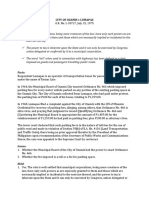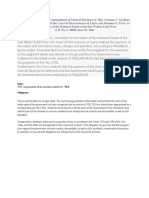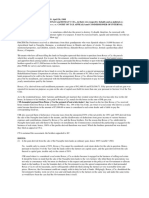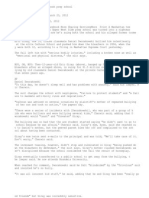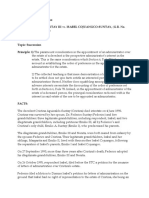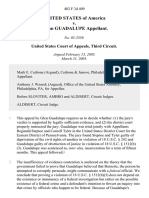Tax Case Digest: PB Com V. CIR (1999) : G.R. No. 112024
Tax Case Digest: PB Com V. CIR (1999) : G.R. No. 112024
Uploaded by
RexCopyright:
Available Formats
Tax Case Digest: PB Com V. CIR (1999) : G.R. No. 112024
Tax Case Digest: PB Com V. CIR (1999) : G.R. No. 112024
Uploaded by
RexOriginal Title
Copyright
Available Formats
Share this document
Did you find this document useful?
Is this content inappropriate?
Copyright:
Available Formats
Tax Case Digest: PB Com V. CIR (1999) : G.R. No. 112024
Tax Case Digest: PB Com V. CIR (1999) : G.R. No. 112024
Uploaded by
RexCopyright:
Available Formats
Tax Case Digest: PB Com V.
CIR (1999)
PB Com v. CIR
G.R. No. 112024 January 28, 1999
QUISUMBING, J.
Lessons Applicable: Lifeblood Theory, Due process of law under the Constitution in Required in
Taxation, BIR function, statute > RMC, State not estopped by mistake of its agents, Claim for refund
in the nature of tax exemption, remedies of refund and tax credit are alternative
Laws Applicable:
FACTS:
Petitioner PBCom reported on its annual Income Tax Return for the year 1985 and 1986
a net loss of P 25, 317, 228 and P 14, 129 602 respectively. But during both year,
PBCom's lessees withheld creditable taxes of P 282 795.50 in 1985 and P 234, 077.69
in 1986.
August 7, 1987: PBCom requested a tax credit for the overpayment of taxes in the 1st
and 2nd quarters.
July 25, 1988: PBCom filed a claim for refund of creditable taxes withheld by lessees.
Pending the investigation, it filed a Petition for Review before the CTA who denied its
request for filing beyond the 2-year reglementary period provided by Sec. 292 and 295 of
the NIRC and the claim for 1986 was denied based on the assumption that it was
automatically credited for the succeeding year as shown in its 1986 adjusted final
corporate annual tax return.
PBCom filed a Motion for Reconsideration and then a Petition for Review with
the CA which affirmed the CTA's decision.
It raised the matter to the SC where it argues that it relief on Rev. Memorandum Circular
No. 285 issued April 1, 1985 that provides that the prescriptive period for overpayment is
NOT 2 years but 10 years under Art. 114 of the Civil Code
ISSUE:
1. W/N PBCom can rely on RMC No. 785 changing the prescriptive period from 2 to 10 years
2. W/N PBCom can be assumed to assail of tax crediting
HELD: petition is hereby DENIED
1. No.
Taxes are the lifeblood of the nation. Due process of law under the Constitution does
not require judicial proceedings in tax cases. This must necessarily be so because it is
upon taxation that the government chiefly relies to obtain the means to carry on its
operations and it is of utmost importance that the modes adopted to enforce the
collection of taxes levied should be summary and interfered with as little as possible.
From the same perspective, claims for refund or tax credit should be exercised within the
time fixed by law because the BIR being an administrative body enforced to collect
taxes, its functions should not be unduly delayed or hampered by incidental matters.
Sec. 230 of the National Internal Revenue Code (NIRC) of 1977 (now Sec. 229, NIRC of
1997) provides for the prescriptive period for filing a court proceeding with the CIR for
the recovery of tax erroneously or illegally collected within 2 years after payment of tax
(computed from the time of filing the Adjustment Return and final payment of the tax for
the year), before any suit in CTA is commenced.
Through the issuance of RMC 7-85, the BIR did NOT simply interpret the law but
legislated guidelines contrary to the statute passed by Congress
RMCs are considered administrative ruling in the same of more specific and less
specific and less general interpretations of tax laws issued by the CIR. It is
entitled great respect by the courts. Nevertheless, such interpretation is not
conclusive and will be ignored if judicially found to be erroneous.
Art. 8 of the Civil Code 26 recognizes judicial decisions, applying or interpreting
statutes as part of the legal system of the country. But administrative decisions
do not enjoy that level of recognition.
Fundamental is the rule that the State cannot be put in estoppel by the mistakes or
errors of its officials or agents
Non-retroactivity of rulings by the Commissioner of Internal Revenue is not
applicable in this case because the nullity of RMC No. 7-85 was declared by
respondent courts and not by the Commissioner of Internal Revenue
Claim for refund is in the nature of a claim for exemption and should be construed in
strictissimi juris against the taxpayer.
2. Yes.
Sec. 69 of the 1977 NIRC (now Sec. 76 of the 1997 NIRC) provides that any excess of
the total quarterly payments over the actual income tax computed in the adjustment or
final corporate income tax return, shall either (a) be refunded to the corporation, or (b)
may be credited against the estimated quarterly income tax liabilities for the quarters of
the succeeding taxable year.
Remedies are in the alternative, and the choice of one precludes the other.
Since credit is opted, can no longer refund.
You might also like
- DIGESTS - Pascual Vs Secretary of Public WorksDocument3 pagesDIGESTS - Pascual Vs Secretary of Public WorksPatricia Bautista100% (4)
- Affirmations For Lawyers BEST 2020Document6 pagesAffirmations For Lawyers BEST 2020glen grahamNo ratings yet
- Mactan Cebu Airport Authority Vs MarcosDocument2 pagesMactan Cebu Airport Authority Vs Marcos上原クリス100% (2)
- Tan V Del Rosario DigestDocument2 pagesTan V Del Rosario DigestJA Quibz100% (2)
- Domingo Vs GarlitosDocument1 pageDomingo Vs GarlitosRon AceNo ratings yet
- LTO v. City of Butuan DigestDocument2 pagesLTO v. City of Butuan DigestKai128100% (1)
- Pepsi-Cola v. TanauanDocument2 pagesPepsi-Cola v. TanauanIshNo ratings yet
- Deutsche Bank Ag Manila Branch vs. CirDocument2 pagesDeutsche Bank Ag Manila Branch vs. CirSalma Gurar100% (3)
- CIR v. Algue, Inc., G.R. No. L-28896Document1 pageCIR v. Algue, Inc., G.R. No. L-28896fay garneth buscato67% (3)
- Mactan Cebu International Airport Authority v. MarcosDocument2 pagesMactan Cebu International Airport Authority v. MarcosKabataan Party-List100% (5)
- City of Ozamis V LumapasDocument3 pagesCity of Ozamis V LumapasViolet ParkerNo ratings yet
- Air Canada v. CIR DigestDocument2 pagesAir Canada v. CIR Digestpinkblush71780% (5)
- National Power Corporation vs. Province of AlbayDocument1 pageNational Power Corporation vs. Province of AlbayIsh100% (3)
- Osmena V Orbos GR No 99886 Case DigestDocument2 pagesOsmena V Orbos GR No 99886 Case DigestCristel Villaruel100% (5)
- G.R. No. L - 41383Document2 pagesG.R. No. L - 41383siahky100% (2)
- Fisher V TrinidadDocument2 pagesFisher V TrinidadEva Marie Gutierrez Cantero100% (3)
- CIR V CA, CTA, YMCADocument2 pagesCIR V CA, CTA, YMCAChil Belgira100% (3)
- La Suerte Vs CA DigestDocument1 pageLa Suerte Vs CA DigestMarc Dave Alcarde100% (2)
- Philippine Bank of Communications V. Cir G.R. No. 112024 January 28, 1999 Quisumbing, JDocument2 pagesPhilippine Bank of Communications V. Cir G.R. No. 112024 January 28, 1999 Quisumbing, Jbrendamanganaan100% (1)
- CIR v. PLDTDocument2 pagesCIR v. PLDTKing Badong100% (1)
- Planters Products Inc vs. Fertiphil CorpDocument2 pagesPlanters Products Inc vs. Fertiphil CorpJoesil Dianne100% (1)
- Domingo vs. Garlitos (8 SCRA 443, G.R. No. L-18994, June 29, 1963)Document1 pageDomingo vs. Garlitos (8 SCRA 443, G.R. No. L-18994, June 29, 1963)Jennilyn Gulfan YaseNo ratings yet
- Pepsi Cola v. City of Butuan DigestDocument2 pagesPepsi Cola v. City of Butuan DigestAnonymous PbYTL9zzco100% (1)
- Gomez Vs PalomarDocument2 pagesGomez Vs PalomarKim Lorenzo CalatravaNo ratings yet
- CIR vs. Goodyear 216130Document1 pageCIR vs. Goodyear 216130magenNo ratings yet
- Caltex v. COA DigestDocument2 pagesCaltex v. COA Digestpinkblush717100% (1)
- CIR Vs CTA DigestDocument2 pagesCIR Vs CTA DigestAbilene Joy Dela Cruz71% (7)
- Abakada Vs ErmitaDocument1 pageAbakada Vs ErmitaLizzette Dela PenaNo ratings yet
- Roxas v. CTADocument2 pagesRoxas v. CTAJoyce Espiritu100% (1)
- Mactan-Cebu International Airport Authority (MCIAA) v. City of Lapu-Lapu and PacaldoDocument2 pagesMactan-Cebu International Airport Authority (MCIAA) v. City of Lapu-Lapu and PacaldoJoshua Borres100% (1)
- Pagcor Vs BirDocument1 pagePagcor Vs Bir001nooneNo ratings yet
- Reyes v. AlmanzorDocument5 pagesReyes v. AlmanzorPatricia BautistaNo ratings yet
- Hilado vs. CIRDocument2 pagesHilado vs. CIRAlan Gultia100% (2)
- British American Tobacco v. Camacho Case DigestDocument3 pagesBritish American Tobacco v. Camacho Case DigestMak Francisco100% (1)
- Sison Vs AnchetaDocument2 pagesSison Vs AnchetadasfghkjlNo ratings yet
- CIR V Marubeni CorpDocument2 pagesCIR V Marubeni CorpJaz Sumalinog75% (8)
- City of Baguio v. Fortunato de Leon GR L-24756Document1 pageCity of Baguio v. Fortunato de Leon GR L-24756Charles Roger RayaNo ratings yet
- Domingo vs. GarlitosDocument2 pagesDomingo vs. GarlitosMichelleNo ratings yet
- CIR v. FortuneDocument2 pagesCIR v. FortunedelayinggratificationNo ratings yet
- 1 - Conwi vs. CTA DigestDocument2 pages1 - Conwi vs. CTA Digestcmv mendozaNo ratings yet
- Tan vs. Del Rosario and CIR, G.R. No. 109289, October 3, 1994Document3 pagesTan vs. Del Rosario and CIR, G.R. No. 109289, October 3, 1994Maria Fiona Duran Merquita100% (1)
- Casanova vs. Hord (G.R. No. 3473 March 22, 1907) - H DIGESTDocument2 pagesCasanova vs. Hord (G.R. No. 3473 March 22, 1907) - H DIGESTHarleneNo ratings yet
- Republic v. Mambulao Lumber Co.Document2 pagesRepublic v. Mambulao Lumber Co.Joni Aquino50% (2)
- CIR vs. ST Lukes DigestDocument2 pagesCIR vs. ST Lukes DigestKath Leen100% (4)
- Caltex Philippines V CoaDocument1 pageCaltex Philippines V CoaJL A H-Dimaculangan100% (3)
- (Digest) Chavez v. OngpinDocument1 page(Digest) Chavez v. OngpinHomer SimpsonNo ratings yet
- Domingo Vs GarlitosDocument1 pageDomingo Vs GarlitosSORITA LAWNo ratings yet
- Commissioner of Internal Revenue, Petitioner, vs. Fortune Tobacco Corporation, RespondentDocument1 pageCommissioner of Internal Revenue, Petitioner, vs. Fortune Tobacco Corporation, RespondentJoshua Erik MadriaNo ratings yet
- MERALCO V Province of LagunaDocument2 pagesMERALCO V Province of LagunaJaz Sumalinog100% (2)
- Phil. Guaranty Co., Inc. v. Cir, 13 Scra 775 - The Lifeblood Doctrine - DigestDocument2 pagesPhil. Guaranty Co., Inc. v. Cir, 13 Scra 775 - The Lifeblood Doctrine - DigestKate Garo100% (3)
- Davao Gulf Lumber Corp V CIRDocument3 pagesDavao Gulf Lumber Corp V CIRAiken Alagban LadinesNo ratings yet
- Deutsche Bank AG Manila Branch v. CIRDocument3 pagesDeutsche Bank AG Manila Branch v. CIRDonna DumaliangNo ratings yet
- 1 Digested Kapatiran NG Mga Naglilingkod Sa Pamahalaan V TanDocument2 pages1 Digested Kapatiran NG Mga Naglilingkod Sa Pamahalaan V TanRoli Sitjar Arangote100% (1)
- YMCA v. CIR, 298 SCRA - THE LIFEBLOOD DOCTRINE - DigestDocument2 pagesYMCA v. CIR, 298 SCRA - THE LIFEBLOOD DOCTRINE - DigestKate GaroNo ratings yet
- Cir Vs Phil American Accident InsuranceDocument2 pagesCir Vs Phil American Accident InsuranceFredrick Atienza100% (1)
- CIR Vs The Estate of TodaDocument3 pagesCIR Vs The Estate of TodaLDNo ratings yet
- Sison Vs AnchetaDocument1 pageSison Vs AnchetaJf Maneja100% (3)
- G.R. No. 109289 October 3, 1994 TAN V. DEL ROSARIO FACTS FactsDocument1 pageG.R. No. 109289 October 3, 1994 TAN V. DEL ROSARIO FACTS FactsGeorginaNo ratings yet
- Paseo Realty & Dev. Corp. vs. CA, CTA, and CIR Case DigestDocument2 pagesPaseo Realty & Dev. Corp. vs. CA, CTA, and CIR Case DigestReniel Eda100% (2)
- Sec 320, NIRC (See Notes) Provides The 2-Year Prescriptive Period For Filing A Court Proceeding For The Recovery of TaxDocument3 pagesSec 320, NIRC (See Notes) Provides The 2-Year Prescriptive Period For Filing A Court Proceeding For The Recovery of TaxPio MathayNo ratings yet
- PBCOM v. CIR Case DigestDocument4 pagesPBCOM v. CIR Case DigestCareenNo ratings yet
- 76 People-of-the-Philippines-v-Quinanola DigestDocument1 page76 People-of-the-Philippines-v-Quinanola DigestRexNo ratings yet
- 75 People Vs PalonDocument1 page75 People Vs PalonRexNo ratings yet
- 67 PP v. Molina 311 S 517, July 28, 1999Document1 page67 PP v. Molina 311 S 517, July 28, 1999RexNo ratings yet
- (DIGEST) People vs. Pinca, 318 SCRA 270, November 17, 1999Document2 pages(DIGEST) People vs. Pinca, 318 SCRA 270, November 17, 1999RexNo ratings yet
- 65 People Vs UycoqueDocument2 pages65 People Vs UycoqueRexNo ratings yet
- 54 People Vs Real DigestDocument1 page54 People Vs Real DigestRexNo ratings yet
- 52 Bacabac vs. People G.R. No. 149372 September 11, 2007Document1 page52 Bacabac vs. People G.R. No. 149372 September 11, 2007RexNo ratings yet
- 49 People vs. Pajares, 210 SCRA 237 June 23, 1992Document2 pages49 People vs. Pajares, 210 SCRA 237 June 23, 1992RexNo ratings yet
- 51 People Vs Canete Et Al DIGESTDocument1 page51 People Vs Canete Et Al DIGESTRex100% (1)
- 40 Ang vs. CA Et Al., 618 SCRA 592 April 20, 2010Document2 pages40 Ang vs. CA Et Al., 618 SCRA 592 April 20, 2010RexNo ratings yet
- 44 People Vs NepomucenoDocument1 page44 People Vs NepomucenoRexNo ratings yet
- People vs. Marivic GenosaDocument1 pagePeople vs. Marivic GenosaRexNo ratings yet
- 43 People V Jacinto DigestDocument1 page43 People V Jacinto DigestRexNo ratings yet
- 50 Obiasca v. Basallote GR No. 176707 February 17, 2010Document28 pages50 Obiasca v. Basallote GR No. 176707 February 17, 2010RexNo ratings yet
- (DIGEST) Dabalos vs. RTC Branch 59, Angeles City, 688 SCRA 64, January 7, 2013Document1 page(DIGEST) Dabalos vs. RTC Branch 59, Angeles City, 688 SCRA 64, January 7, 2013RexNo ratings yet
- 35 Paera Vs People DigestDocument1 page35 Paera Vs People DigestRexNo ratings yet
- 47 Barcellano v. Bañas GR No. 165287 September 14, 2011Document6 pages47 Barcellano v. Bañas GR No. 165287 September 14, 2011RexNo ratings yet
- 38 Yapyuco vs. Sandiganbayan 624 SCRA 470 June 25, 2012Document2 pages38 Yapyuco vs. Sandiganbayan 624 SCRA 470 June 25, 2012RexNo ratings yet
- 37 RUPERTO CABANLIG Vs Sandiganbayan DigestDocument1 page37 RUPERTO CABANLIG Vs Sandiganbayan DigestRexNo ratings yet
- 51 Liwag v. Happy Glen Loop Homeowners Assoc. GR No. 189755 July 4, 2012Document9 pages51 Liwag v. Happy Glen Loop Homeowners Assoc. GR No. 189755 July 4, 2012RexNo ratings yet
- 46 Bolos v. Bolos, G.R. No. 186400, October 20, 2010Document7 pages46 Bolos v. Bolos, G.R. No. 186400, October 20, 2010RexNo ratings yet
- Latifah Bte Mat Zin V Rosmawati Bte SharibunDocument20 pagesLatifah Bte Mat Zin V Rosmawati Bte SharibunNur Ain Yusof100% (1)
- Xavier University College of Law Taxation Ii Atty. Viktoria Villo-MurilloDocument24 pagesXavier University College of Law Taxation Ii Atty. Viktoria Villo-MurilloJasper AlonNo ratings yet
- Ra 8344Document2 pagesRa 8344Kila AdameNo ratings yet
- People v. Dagani, G.R. No. 153875, 16 August 2006, 499 SCRA 64Document9 pagesPeople v. Dagani, G.R. No. 153875, 16 August 2006, 499 SCRA 64Snow IbukiNo ratings yet
- 4 Topacio V OngDocument1 page4 Topacio V OngFrancesca Isabel MontenegroNo ratings yet
- RR 4-86Document2 pagesRR 4-86Mico Maagma CarpioNo ratings yet
- Aida D. Eugenio vs. Civil Service Commission, Hon. Teofisto T. Guingona, Jr. & Hon. Salvador Enriquez, Jr. G.R. No. 115863 March 31, 1995Document2 pagesAida D. Eugenio vs. Civil Service Commission, Hon. Teofisto T. Guingona, Jr. & Hon. Salvador Enriquez, Jr. G.R. No. 115863 March 31, 1995Russ TuazonNo ratings yet
- People v. OcfemiaDocument2 pagesPeople v. OcfemiaNinaNo ratings yet
- Iran vs. USDocument3 pagesIran vs. USAmelyn Albitos-Ylagan Mote100% (1)
- 03 Jamer v. NLRCDocument2 pages03 Jamer v. NLRCCarlo Fernandez100% (1)
- Chapter X (Secs. 182 To 238) of The Indian Contract Act, 1872Document25 pagesChapter X (Secs. 182 To 238) of The Indian Contract Act, 1872Asmi SNo ratings yet
- Pu Blic Corp Full Text CasesDocument318 pagesPu Blic Corp Full Text CasesarielramadaNo ratings yet
- UntitledDocument2 pagesUntitledavery3320No ratings yet
- Prohibited PleadingDocument3 pagesProhibited PleadingYui RecintoNo ratings yet
- Module 3: The Professionals and Practitioners in The Discipline of CommunicationDocument8 pagesModule 3: The Professionals and Practitioners in The Discipline of CommunicationColeen gaboy100% (2)
- Regala v. Sandiganbayan FactsDocument10 pagesRegala v. Sandiganbayan FactsJIJAMNNo ratings yet
- Law On Public Corporation (Largo) Reviewer Pt. 2Document30 pagesLaw On Public Corporation (Largo) Reviewer Pt. 2Mia Alba100% (1)
- 9 People of The Philippines Vs Arturo MauyaoDocument3 pages9 People of The Philippines Vs Arturo MauyaoiluveboxNo ratings yet
- Christos D. Dedes Christos D. Dedes, as Legal Custodian for His Children Quincy Sophia Dedes and Dionysios Christos Dedes All Parents Similarly Situated v. Roswell Page John O'BriOn Murray J. Janus Sylvia Clute Donald Lemons Alfred Shilling Daniel T. Balfour Melvin R. Hughes, Honor Able, Judge of the Circuit Court in the City of Richmond Richard L. Williams, Honorable, Judge of the United States District Court for the Eastern District of Virginia, Christos D. Dedes Christos D. Dedes, as Legal Custodian for His Children Quincy Sophia Dedes and Dionysios Christos Dedes, and All Parents Similarly Situated v. Roswell Page John O'BriOn Murray J. Janus Sylvia Clute Donald Lemons Alfred Shilling Daniel T. Balfour Melvin R. Hughes, Judge of the Circuit Court in the City of Richmond Richard L. Williams, Judge of the United States District Court for the Eastern District of Virginia, 46 F.3d 1123, 4th Cir. (1995)Document3 pagesChristos D. Dedes Christos D. Dedes, as Legal Custodian for His Children Quincy Sophia Dedes and Dionysios Christos Dedes All Parents Similarly Situated v. Roswell Page John O'BriOn Murray J. Janus Sylvia Clute Donald Lemons Alfred Shilling Daniel T. Balfour Melvin R. Hughes, Honor Able, Judge of the Circuit Court in the City of Richmond Richard L. Williams, Honorable, Judge of the United States District Court for the Eastern District of Virginia, Christos D. Dedes Christos D. Dedes, as Legal Custodian for His Children Quincy Sophia Dedes and Dionysios Christos Dedes, and All Parents Similarly Situated v. Roswell Page John O'BriOn Murray J. Janus Sylvia Clute Donald Lemons Alfred Shilling Daniel T. Balfour Melvin R. Hughes, Judge of the Circuit Court in the City of Richmond Richard L. Williams, Judge of the United States District Court for the Eastern District of Virginia, 46 F.3d 1123, 4th Cir. (1995)Scribd Government DocsNo ratings yet
- Suntay III Vs Cojuangco-Suntay - SuccessionDocument5 pagesSuntay III Vs Cojuangco-Suntay - Successionbebs CachoNo ratings yet
- Bersamin Tax CasesDocument2 pagesBersamin Tax CasesJustine EspinolaNo ratings yet
- This Content Downloaded From 14.139.214.181 On Fri, 16 Oct 2020 07:00:05 UTCDocument7 pagesThis Content Downloaded From 14.139.214.181 On Fri, 16 Oct 2020 07:00:05 UTCAyush PandeyNo ratings yet
- Ra 6713 Code of ConductDocument36 pagesRa 6713 Code of ConductSandra Kaye Nonan CalicaNo ratings yet
- Landmark Judgments of The Supreme Court of India: Ultra Vires and IllegalDocument54 pagesLandmark Judgments of The Supreme Court of India: Ultra Vires and Illegalakshat0tiwariNo ratings yet
- Principles Law On TrustsDocument3 pagesPrinciples Law On TrustsAnthony Yap100% (2)
- United States v. Glenn Guadalupe, 402 F.3d 409, 3rd Cir. (2005)Document9 pagesUnited States v. Glenn Guadalupe, 402 F.3d 409, 3rd Cir. (2005)Scribd Government DocsNo ratings yet
- Globe Mackay Cable v. CA (Full Text and Digest)Document9 pagesGlobe Mackay Cable v. CA (Full Text and Digest)Janine OlivaNo ratings yet
- Certification Transcript of RecordsDocument45 pagesCertification Transcript of RecordsFidelis AijouNo ratings yet
- Pobre Vs Defensor-Santiago, A.C No. 7399, Aug 2009Document3 pagesPobre Vs Defensor-Santiago, A.C No. 7399, Aug 2009Marlouis U. Planas100% (3)










